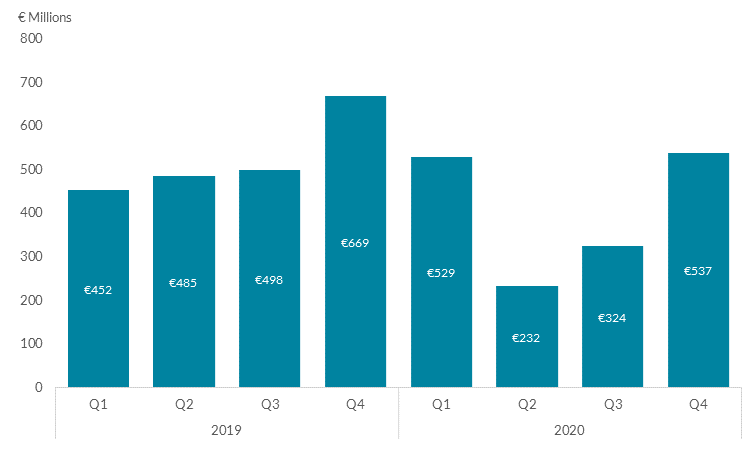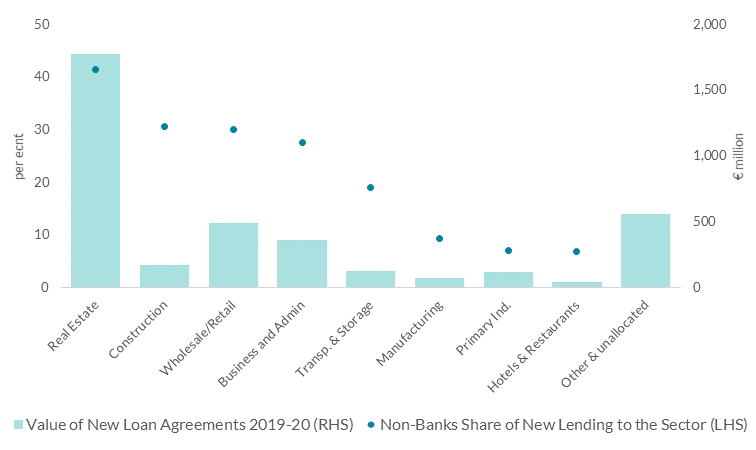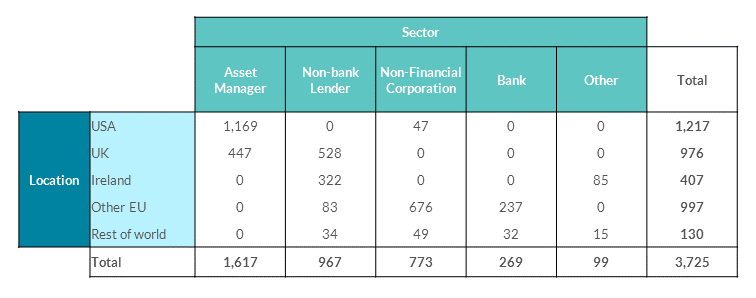Behind the Data
The role of non-bank lenders in financing Irish SMEs
Tiernan Heffernan, Barra McCarthy, Rory McElligott and Conall Scollard*
April 2021
Irish SMEs borrowed almost €4bn from non-bank lenders between 2019 -2020, across a wide variety of products. But which SME sectors are most reliant on this type of borrowing and what do we know about these lenders?
Non-bank lenders are not a new feature in the Irish market, but market commentary points to an increased presence over the past decade. They provide increased choice for borrowers, competition for banks, financing in market segments underserved by other lenders, and innovations in products and funding models. Their position as a key part of the SME funding ecosystem was demonstrated by the inclusion of non-bank lenders in the government’s COVID-19 Credit Guarantee Scheme, as well as by participation in a range of SBCI loan schemes over the past decade. The changing landscape in Irish banking implies a likely growing role for non-bank financial intermediaries in financing SMEs, which hastens the need to understand the role these entities currently play.
Despite the reported growth of non-bank lenders, their activity has not yet been detailed in official data. As a result, analysis to deepen the understanding of the role of non-bank lenders for SMEs has been somewhat hampered. In contrast, the role of market based finance, where significant data already exists is studied in more detail, but is a funding source often only accessible to larger firms (Lawless et al., 2013, Golden & Hughes, 2018, Cima et al., 2019).
International evidence suggests that the pass-through of monetary policy by non-bank lenders may differ to the well-understood bank-lending channel (Elliot et al, 2020). Differences in non-banks’ behaviour has led the ECB monetary policy strategy review to set up a workstream to examine how the growing role of non-banks influences the transmission of monetary policy.
There is also evidence that bank and non-bank lending can have different risk profiles (Chernenko et al., 2019; Tsuruta, 2010; Denis and Mihov, 2003; Carey et al., 1998). This can play an important role in improving access to finance to a wider range of borrowers, but it may also result in excessive leverage in some SMEs or lending to firms with poorer performance. This creates a possibility of unexpected losses and sensitivity to changing economic conditions. In such situations, understanding the interconnections between non-banks and other sectors, and the resilience of the funding model across the economic cycle, is very important to support financial stability.
This Behind the Data hopes to fill this gap in our knowledge by providing some insights into non-bank lending to Irish companies and sole traders. By combining a range of granular databases, we investigate the scale of non-bank lending by sector to Irish SMEs and provide a profile of non-bank lenders.
The Data
There are little official data on the scale of borrowing of Irish SMEs from non-banks, but the Central Credit Register (CCR) now allows us to estimate this. The CCR contains records on loans granted over €500, where the borrower is an Irish resident at the time of applying for the loan and/or the loan is governed by Irish law.
This Behind the Data focuses on new loan agreements provided by non-banks to Irish resident SMEs in 2019 and 2020. Non-bank lenders are defined as entities originating new loans that are not banks, credit unions (as they are already contained within existing credit institution statistics) or government-sponsored entities. NAMA, local authorities, and vehicles that are solely involved in the purchase of loans from other lenders are excluded.
To enhance the information available on the borrower characteristics, we merge the CCR records with other firm level registers including Irish input into the Register of Affiliates and Assets Database and the Company Registration Office (CRO). Finally, information of ownership structures of the non-bank lenders is sourced from individual financial reports to the CRO and Central Bank reporting on Special Purpose Entities (SPE).
A number of caveats exist:
- Some loans do not fall under the scope of the CCR.As such, crowdfunding is not covered in this note.
- Manual adjustments and appropriate assumptions have been applied to relevant attributes to support completeness and consistency. In such cases, manual adjustments are required. For example, we remove firms flagged as SME when a loan is inconsistent with the balance sheet size of an SME. When no SME flag is available at all, we apply a cut-off and only include loans of €1 million or less, in line with a proxy for SME borrowers in other statistical collections.
- We use the agreed loan finance amount for the loan size. In some cases, the full finance amount may not be fully drawn-down.In any event, if no part of a loan is drawn-down, then we exclude the loan entirely.
Non-banks lent Irish SMEs €1.6 billion in 2020
Non-bank lenders play a key role in funding SMEs in Ireland. They provided €1.6 billion in new loan agreements to Irish SMEs in 2020, down from €2.1 billion in 2019. In comparison, the Central Bank data show that banks provided €4.1 billion and €5.4 billion in drawn-down new lending in 2020 and 2019 respectively. Overall, Irish SMEs owed non-bank lenders €4.3 billion at end-2020 compared to €19.8 billion owed to banks. The trend in new lending broadly replicates that of the banks throughout the pandemic period in 2020 (Kelly et al, 2021), although the decline in non-bank lending in Q2 was sharper than observed in bank lending (Chart 1).
Chart 1: Non-bank loan agreements with SMEs

Source: Central Credit Register, CRO, Register of Affiliates and Assets Database and Central Bank of Ireland calculations.
Non-bank lenders tend to specialise in specific sectors or product lines (e.g. leasing), which means the importance of non-banks for each economic sector varies significantly. Lending to real estate SMEs had the largest share at €1.8 billion between 2019 and 2020. These firms also received the largest share (41 per cent) of their borrowing from non-banks (Chart 2). This is primarily in the residential development area of the market, where banks have reduced activity since the last financial crisis. The role of non-banks in the Irish property market has been well documented, but to date this has primarily focused on ownership of property, rather than funding of the development (Daly et al, 2021). The data highlights the importance of non-banks for funding real-estate development in the Irish market and the importance of ensuring long-term resilience in the business and funding models for credit conditions in the future.
Non-banks also account for a high share of funding for wholesale and retail. This is heavily concentrated in stocking finance for car dealers, and was one of the few sectors to see a growth in lending in 2020. The growth in lending, in part, reflects changing consumer spending patterns and subsequent business changes (see Hopkins & Sherman, 2021). There is also evidence of increased prevalence of roll-over lending in the car stocking finance, with the reduced car sales activities resulting in stock being refinanced as sales stay depressed.
The primary industry (including agriculture), hotels and manufacturing sectors are much more reliant on banks for funding, with approximately only 7 per cent of their loans sourced from non-bank lenders.
Chart 2: Sectoral use of non-bank loans
(new lending volumes 2019-2020)
Source: Central Bank of Ireland Statistics, Central Credit Register, CRO, RIAD and Central Bank of Ireland calculations.
Who are the non-bank lenders?
The analysis of the CCR loans identifies 63 non-bank lenders to Irish SME in 2019 and 2020. The lenders are diverse, and include many small lenders. Only 22 entities lent in excess of €50 million over the two-year period.
Many lenders are specialists providing specific types of loans or loans to specific types of borrowers. The two largest examples, asset finance and leasing, and property finance, together account for €2.3 billion of new lending agreements over 2019-2020. Property financing companies provide a suite of lending products to fund the development and purchase of property, and naturally have the strongest relationship with real estate SME firms (Chart 3). Asset and leasing lenders finance asset and equipment purchase, or provide leases on assets or equipment. Such lenders have links with many SME sectors, but also account for a large part of the non-bank borrowing for many sectors, especially the wholesale/retail and primary industry sectors.
There are also non-banks who lend to many borrowers and have multiple types of credit products, whom we refer to as General Business Lenders. These lenders commonly provide leasing, asset finance and property financing products among terms loans and other products. The diversity of their lending product line and customer base is evident in Chart 3. These General Business Lenders concluded loan agreements worth €1 billion in 2019 and 2020.
Other types of specialist’s lenders include insurance premium or professional fees financing lending almost €160 million over the two-years.
Chart 3. Flow of Non-Bank Credit, from lender to borrower
(€ million; new lending volumes 2019-2020)

Source: Central Credit Register, CRO, RIAD and Central Bank of Ireland calculations.
17 of the legal entities that provided SME lending are structured as SPEs, established under Section 110 legislation. These are predominantly involved in real estate lending and account for €1.1 billion or 40 per cent of the non-bank lending to SMEs in 2019 and 2020. Loans are held within the SPE for the purpose of ring-fencing the loans for asset backed funding. Many originators of these loans have a significant business presence in terms of staff and physical offices, and are not simply pass-through vehicles, as is the case of some other Irish SPEs.
The ultimate owners of non-bank lenders are geographically diverse, ranging from North America, Europe, Asia, Australia and Ireland. Just under 90 per cent of the non-bank lending to Irish SMEs over the two-year period were from lenders with non-Irish owners, with US based asset managers being the largest owner group. These asset managers generally specialise in alternative assets, and also invest in private equity, real estate and other forms of credit. UK financial firms account for the next largest cohort of parent firms. In contrast to US and UK owners, European owners tend to be non-financial firms linked to ownership of leasing and asset finance specialists – often the manufacturer of the asset being financed.
While the ownership profile of the non-bank lenders is useful for improving our understanding of the sector, a more detailed analysis of the broader funding profile will benefit our knowledge of the various business models, and potential cross-sectoral contagion channels in the event of a shock.
Table 1: Ultimate Parent of Non-Bank SME Lenders
(€ million; new lending volumes 2019-2020)
Conclusion
This Behind the Data fills a gap in our knowledge by providing insights on non-bank lending to Irish SMEs. We find that non-banks have an important role in funding SMEs, provided €1.7 billion in loans to SME real estate firms between 2019 and 2020. They also provided €2 billion in new loans to a diverse range of SME is the same period with leasing and asset financing playing a large role. The lenders are owned by parents from across the globe, and are active across a wide range of economic sectors, but property and wholesale/retail businesses are particularly dependent on non-bank lenders.
Non-banks are playing an increasing role in financing Irish businesses, and an alternative lender to the traditional banking system. Further work will be required to better establish the role of non-banks in credit conditions in the Irish market, in particular the resilience and sustainability of all the business models throughout the economic cycle.
*Email [email protected] if you have any comments or questions on this note. Comments from Maria Woods, Patrick Haran, Jenny Osbourne Kinch, Simone Saupe, Fergal McCann, Mark Cassidy, Vasileios Madouros, John Connolly, Deirdre Dalton and Caroline Mehigan are gratefully acknowledged. The views expressed in this note are those of the authors and do not necessarily reflect the views of the Central Bank of Ireland or the ESCB.
See also: